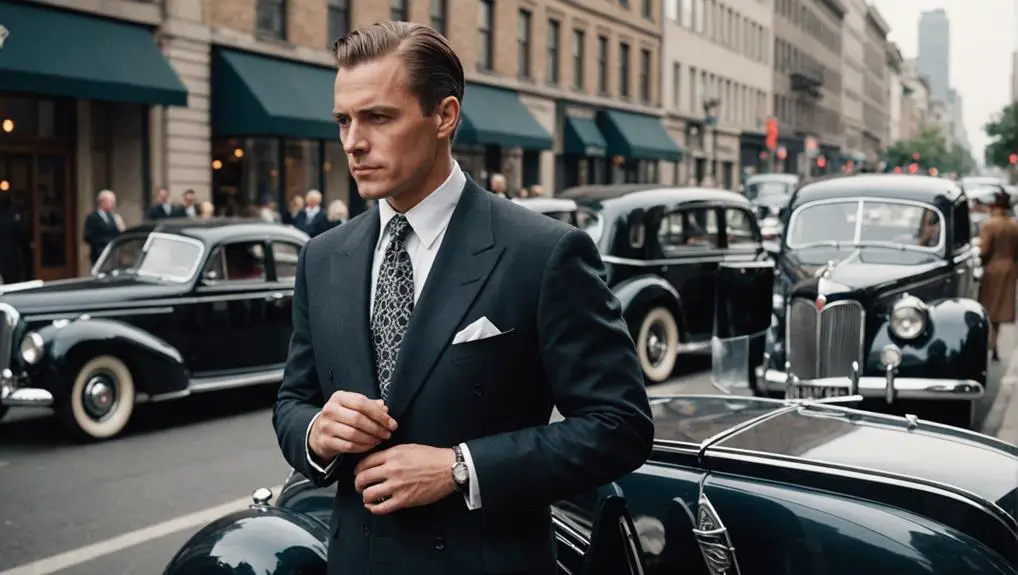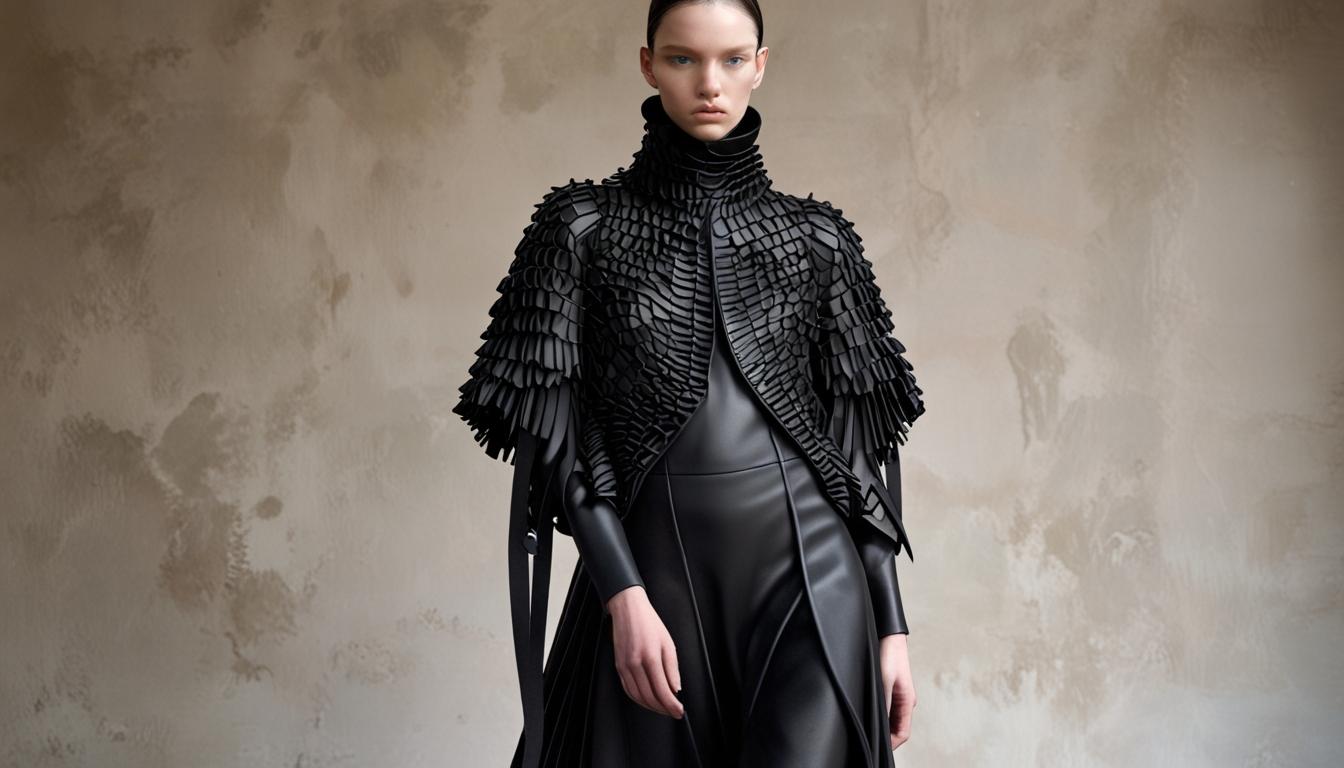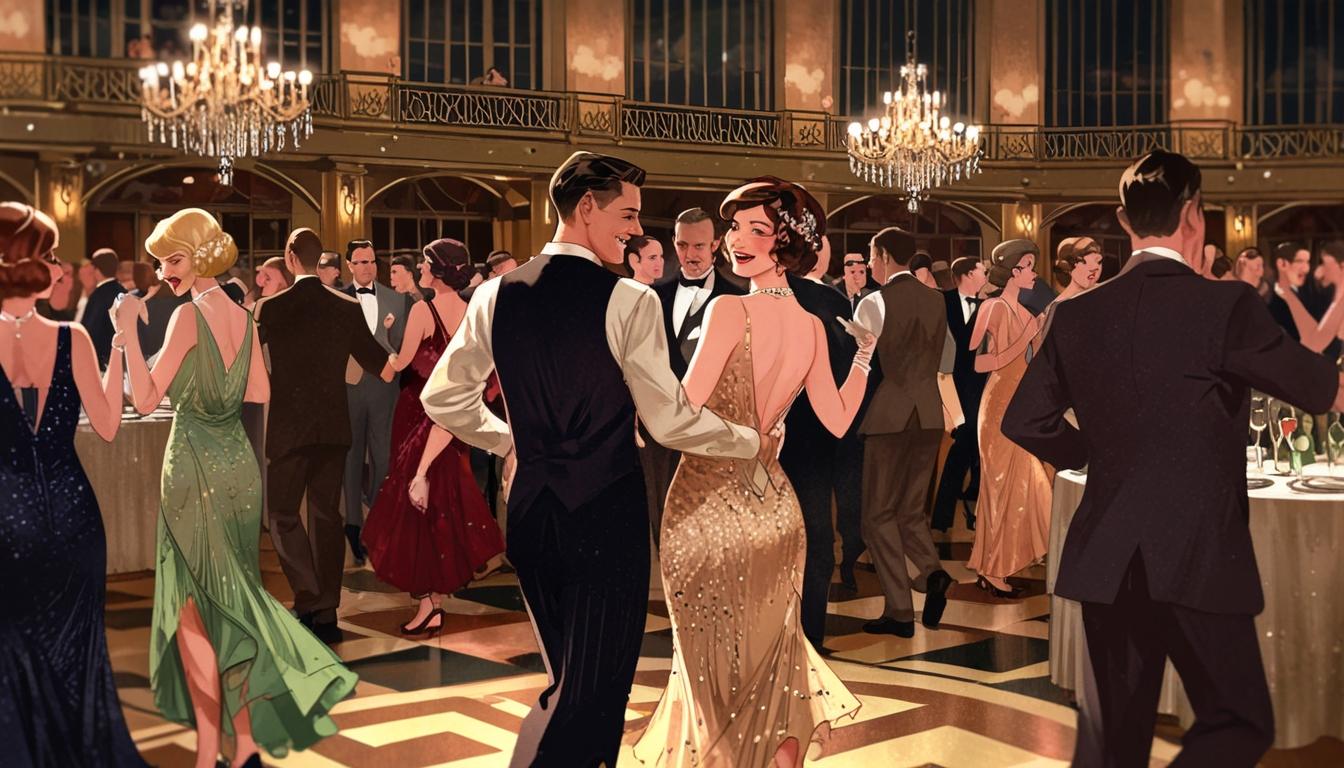In the 1940s, men's tie clips became essential fashion accessories, perfectly embodying the era's elegance and sophistication. These stylish pieces weren't just practical—they offered a refined touch to your wardrobe, thanks to their gold, silver, and brass designs. You'd find minimalistic shapes and intricate patterns, reflecting craftsmanship that told a story. With Hollywood stars influencing trends, tie clips transformed the way men expressed their style. Today, these vintage accessories have gained collector interest, making them both fashion statements and investments. Discover more about the unique designs and market value that make these tie clips so enchanting!
Historical Context of Tie Clips
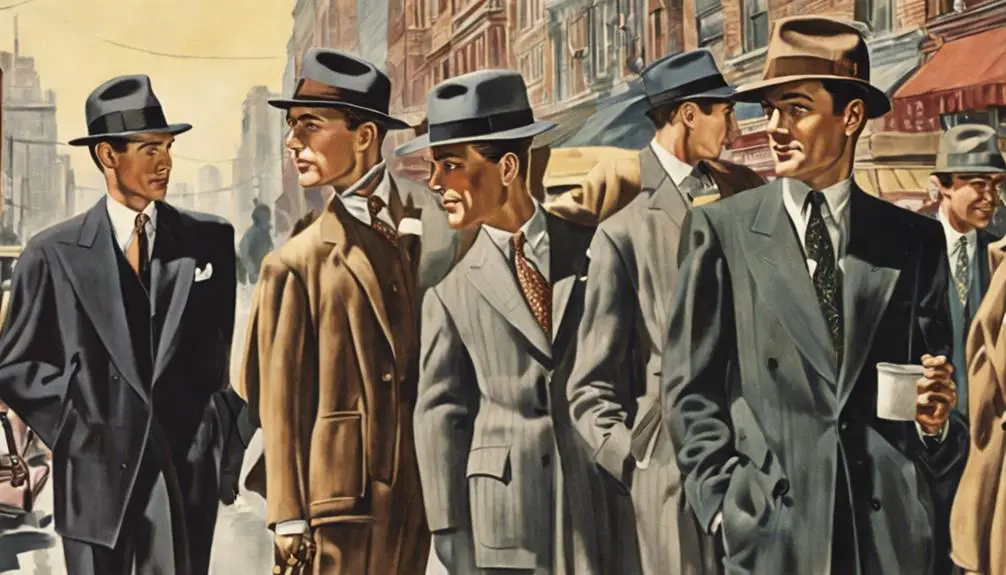
The 1940s marked a pivotal moment in men's fashion, as tie clips emerged as essential accessories that defined a polished look. This decade witnessed a notable shift towards elegance and sophistication in men's attire, with tie clips playing a vital role in achieving a refined appearance. As men returned from the war, the desire to present themselves well in professional settings became paramount. Tie clips offered a practical solution—keeping ties in place and preventing them from flapping during movement.
During this era, vintage tie clips adopted various designs, often showcasing simple lines adorned with elegant embellishments. These accessories not only served a functional purpose but also reflected the luxury aesthetics of the time. Crafted from materials like gold, silver, and stainless steel, tie clips embodied the post-war emphasis on quality and style.
Today, vintage tie clips from the 1940s are highly sought after by collectors, with their rarity and condition greatly influencing their market value. Owning a piece from this era allows you to connect with a time when men's fashion was about making a statement—a reflection of timeless elegance and sophistication.
Design Features of 1940s Tie Clips
Vintage tie clips from the 1940s showcase a striking blend of elegance and functionality, making them a standout accessory in men's fashion. Each tie clip exudes sophistication, capturing the essence of the era while complementing your formal attire perfectly. Here are some notable design features that define these classic pieces:
- Minimalistic Shapes: The tie clips often featured sleek, classic shapes that emphasized elegance and charm.
- Material Variety: Crafted from gold-toned metals, silver, and stainless steel, these clips not only boasted durability but also a polished aesthetic.
- Decorative Elements: Many vintage mens tie clips included intricate engravings, simple geometric patterns, or subtle embellishments like gemstones or enamel accents, showcasing an impressive attention to detail.
- Size Range: Typically measuring between 1.5 to 2.5 inches, these clips suited various tie styles, ensuring they remained a functional and stylish choice.
With their enthralling designs, 1940s tie clips are more than just accessories; they're a celebration of timeless fashion, reflecting the era's dedication to sophistication. Whether you're dressing for a formal event or elevating everyday wear, these tie clips are essential for any discerning gentleman.
Functionality and Purpose
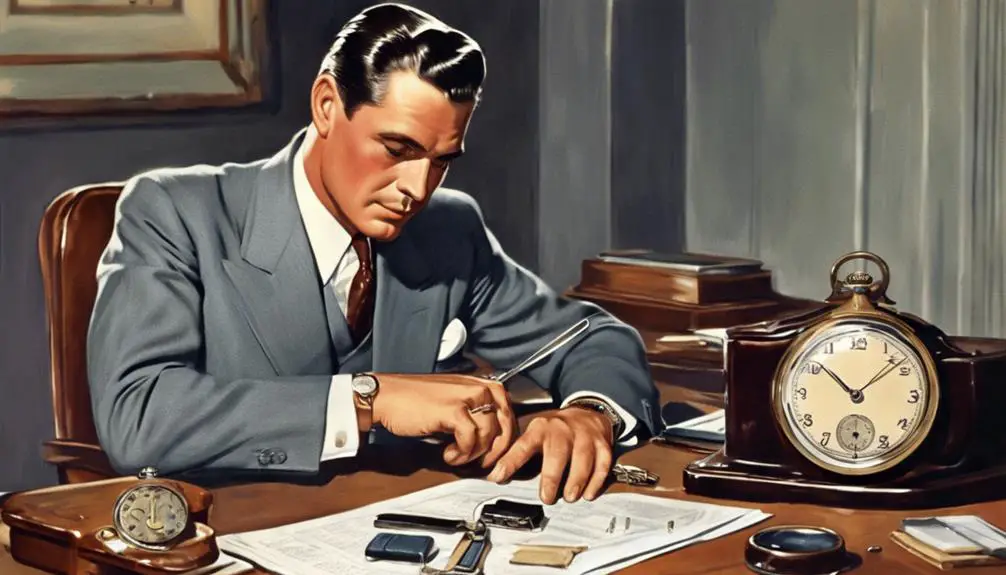
Securing your tie in place while adding a touch of elegance, tie clips from the 1940s served both practical and aesthetic purposes. Their primary functionality was to keep your tie anchored, preventing it from flapping during your daily activities. This guaranteed a polished appearance, which was essential for the sophisticated gentleman of the time.
The design of these accessories was simple yet effective, typically ranging from 1.5 to 2.5 inches in length, making them versatile enough to complement various tie styles. Beyond their practical use, tie clips embodied sophistication, reflecting the cultural shift towards more refined men's fashion in the post-war era.
Crafted from materials like gold, silver, and brass, they often featured decorative elements such as engravings or stones, allowing you to showcase your personal style. With each clip, you added not just functionality but also a layer of elegance to your ensemble. In a world focused on the details, men's tie clips became a symbol of refinement, proving that even the smallest accessories could make a significant impact on your overall look.
Collectibility and Market Value
Collectors are increasingly drawn to 1940s tie clips, captivated by their historical significance and craftsmanship. These vintage accessories are not only stylish but also represent a fascinating era in men's fashion, much like the distinctive labels found in vintage clothing from well-known brands. As demand rises, the collectibility of these pieces has soared, with some commanding impressive market values. Understanding vintage characteristics can enhance appreciation for these unique items.
Here are a few key factors affecting their collectibility and market value:
- Condition: A tie clip's state markedly impacts its worth, categorized as mint, excellent, or good.
- Brand Reputation: Well-known brands like SWANK and Anson are highly sought after, elevating their collectible status.
- Rarity: Limited edition or unique designs often fetch higher prices at auctions or vintage shops.
- Market Trends: As interest in vintage fashion grows, these tie clips are viewed as both functional accessories and investments.
You'll find that prices can vary widely, with some rare pieces selling for hundreds of dollars. As you explore the world of 1940s tie clips, you're not just acquiring a stylish accessory but also a piece of history that could appreciate in value over time.
Popular Materials Used
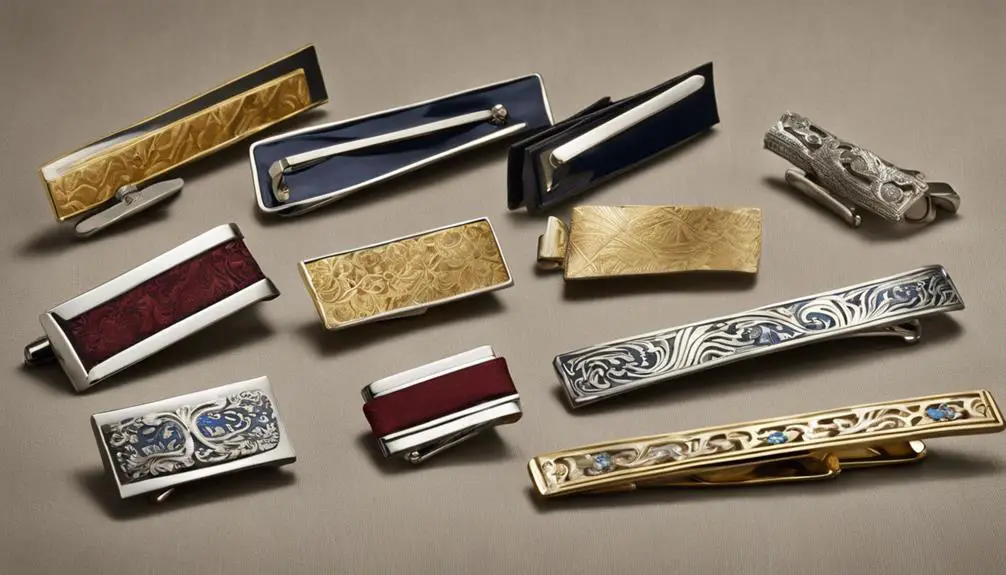
In the 1940s, tie clips often showcased a blend of elegance and durability, crafted from materials like gold, silver, brass, and stainless steel. These materials served not just as functional accessories but also as statements of style. Gold and silver plates were particularly popular, giving you a luxurious look without the hefty price tag of solid metals.
Most tie clips featured a polished finish that sparkled under the light, making them perfect for formal occasions. You'd find that many included decorative elements, such as enamel or gemstones, adding a unique flair to your ensemble.
Here's a quick overview of the materials used:
| Material | Characteristics | Average Length |
|---|---|---|
| Gold | Luxurious, warm tone | 1.5 – 2.5 inches |
| Silver | Classic, versatile | 1.5 – 2.5 inches |
| Brass/Stainless Steel | Durable, affordable | 1.5 – 2.5 inches |
These clips, typically 1.5 to 2.5 inches long, were designed to complement various tie styles while maintaining their primary purpose, keeping your tie perfectly in place.
Care and Maintenance Tips
While you may love showcasing your vintage tie clips, taking proper care of them is essential to keep their elegance intact. Here are some key maintenance tips to guarantee your beloved accessories remain in pristine condition:
- Regular Cleaning: Gently wipe your tie clips with a soft, dry cloth to maintain their shine and remove any dust or residue. This simple step can keep them looking fresh and vibrant.
- Proper Storage: Store your tie clips in a cool, dry place, ideally in a soft pouch or box. This prevents tarnishing and protects them from moisture that can cause damage.
- Avoid Harsh Environments: Steer clear of wearing your tie clips in areas with harsh chemicals or high humidity. Such conditions can accelerate tarnishing and deterioration, compromising their vintage appeal.
- Periodic Inspections: Regularly check your tie clips for signs of wear, like bent clasps or loose embellishments. Handle them with care to avoid bending or breaking, guaranteeing they stay a stylish statement piece in your collection.
Style Trends in the 1940s

Taking care of your vintage tie clips not only preserves their beauty but also allows you to appreciate the style trends that defined men's fashion in the 1940s. This era marked a significant shift towards a polished appearance, especially post-WWII, when tie clips emerged as a timeless accessory for formal and semi-formal attire.
The design elements of 1940s tie clips exude sophistication, featuring sleek lines and geometric shapes that highlight their elegance. Crafted from materials like gold, silver, and stainless steel, these pieces often showcase minimalistic yet striking styles. You might notice decorative engravings or unique finishes, all indicative of exceptional craftsmanship that enhances both functionality and aesthetic appeal.
Hollywood's influence further propelled the popularity of tie clips, with celebrities setting trends that men enthusiastically adopted. This cultural shift inspired a widespread embrace of stylish accessories, transforming them into symbols of refinement. Today, the collectibility of 1940s tie clips has increased, making them highly sought-after items among vintage fashion enthusiasts. Owning one isn't just about wearing a piece of history; it's about celebrating an era where elegance and sophistication reigned supreme.
Modern Relevance and Demand
The resurgence of vintage accessories, particularly men's tie clips from the 1940s, reflects a broader trend in fashion that celebrates nostalgia and timeless style. Today, you'll find that these vintage tie clips are more than just stylish pieces; they embody sophistication and historical significance. As collectors seek to understand the historical context of vintage labels, these pieces are becoming increasingly sought after. Here's why they're in modern demand:
- Unique Designs: Each tie clip tells a story with intricate patterns and craftsmanship that modern accessories often lack.
- Investment Potential: Collectors are snapping up well-known brands, leading to a rise in their value over time.
- Fashion Versatility: Whether at a business meeting or a formal event, tie clips add a polished look that complements your attire.
- Nostalgia in Fashion: The current love for retro styles means vintage tie clips are not just accessories; they're a statement of personal style and appreciation for the past.
As you explore the world of 1940s tie clips, you'll discover that they're not just relics; they're timeless accessories that elevate your wardrobe and reflect a refined sense of fashion. Don't miss out on embracing this trend!
Frequently Asked Questions
When Did Men Start Wearing Tie Clips?
You'll find that men started wearing tie clips in the early 20th century. These stylish accessories quickly gained popularity, enhancing formal attire while keeping ties secure, effortlessly blending function with flair in men's fashion.
Did Men Wear Bow Ties in the 1940s?
Yes, you'd see men sporting bow ties in the 1940s, especially at formal events. They added a sophisticated flair, often made from silk or satin, with vibrant patterns that reflected the era's stylish trends.
What Is the Difference Between a Tie Bar and a Tie Clip?
When choosing between a tie bar and a tie clip, consider their styles. Tie clips grip your tie, while tie bars slide over it. Tie clips are more casual, but tie bars add a polished touch.
What Are the Names for Tie Clips?
Tie clips go by various names like tie bars, tie clasps, and tie slides. Each term reflects a unique design and function, blending style and practicality to elevate your formal wear effortlessly.
